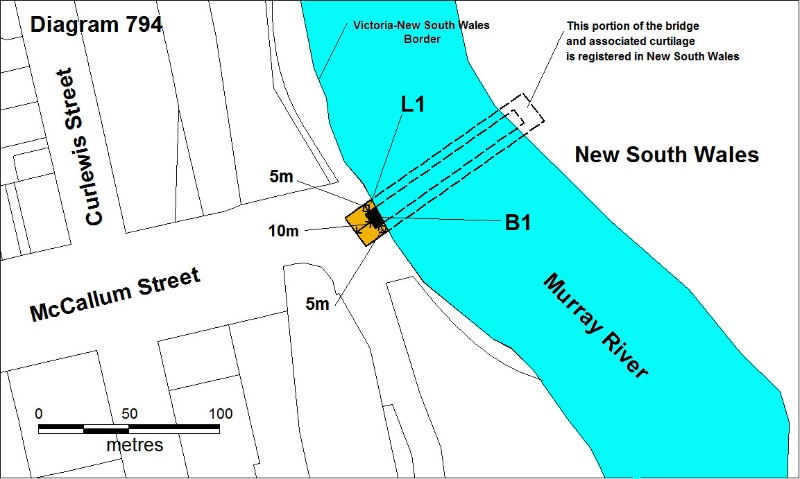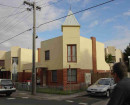SWAN HILL BRIDGE
DENILIQUIN ROAD SWAN HILL, SWAN HILL RURAL CITY
-
Add to tour
You must log in to do that.
-
Share
-
Shortlist place
You must log in to do that.
- Download report









Statement of Significance
Built in 1896 by the Victorian bridge builders, Farquharson Bros, to a design by New South Wales Public Works Department Engineer, Percy Allan, the Swan Hill Bridge is a timber truss and steel centre lift-span bridge over the Murray River at Swan Hill.
The bridge comprises of a timber bridge deck supported by two 27.4m metre long Allan truss spans each side of a 17.8 steel lift-span bridge. The centre lift-span is supported by four cast iron pillars sunk into the riverbed and filled with concrete. The bridge is approached from the New South Wales side by three spans of round timber girders supported by round timber trestles. and from the Victorian side by a single span of round timber girders. The raising and lowering of the bridge deck was designed to allow paddle steamers to pass through.
The bridge is constructed of ironbark from the northern rivers region of New South Wales because of its superior strength and durability. Unlike the local river red gum, which has a tendency to twist and split when sawn into squared timber, ironbark retains its shape and strength.
The Swan Hill region was occupied by a number of large pastoral runs in the decade following Major Mitchell's journey through the area in 1836 and a punt crossing the Murray River was established as early as 1846. The punt attracted further settlement and Swan Hill developed as a centre for the river trade and other interstate commerce. In 1886 the punt crossing was moved to what is now the location of the current bridge. By 1890 the residents of Swan Hill found that the new punt service was inadequate and petitioned for a bridge. The arrival of the railway in Swan Hill in 1889 gave further impetus for the construction of a bridge to further develop intercolonial trade.
The bridge was one of the first using Percy Allan's innovative truss design developed in 1893, which would be used on timber bridges throughout New South Wales. The Swan Hill Bridge is the only Murray Bridge to use the 90ft (27.4m) variation of the truss. No Allan truss bridges were built south of the Murray River. The bridge also includes Allan's improved one man operated lifting mechanism for the central lift-span. This was the first bridge to use the mechanism, which was used on virtually all subsequent lift-spans in Australia.
The Swan Bridge provided a vital link between the pastoral runs in the New South Wales Riverina to the railways on the Victorian side of the Murray allowing easy transport of wool to the Victorian markets and ports. The link also benefited drovers overlanding livestock between Queensland and the Victorian markets. In time the bridge also provided an essential link between the Moulamein-Wakool irrigation areas and the Swan Hill rail head and Victorian markets and sea ports.
How is it Significant?
The Swan Hill Bridge is of historical and technical (scientific) significance to the State of Victoria.
Why is it Significant
The Swan Hill Bridge is of technical (scientific) significance for the innovations used in its design and construction. At the time of construction, the Swan Hill Bridge represented some of the most sophisticated methods in Australian bridge construction.
The Swan Hill Bridge is of historical significance for its associations with engineer Percy Allan who influenced bridge design throughout Australia.
The Swan Hill Bridge is of historical significance for its role in facilitating intercolonial trade between New South Wales and Victoria.
-
-
SWAN HILL BRIDGE - History
The Swan Hill region was occupied by number of large pastoral runs in the decade following Major Mitchells journey through the area in 1836 by a; Murray Downs on the NSW side and Tyntynder and Mercers Vale, established by the Beveridge family as cattle stations on the Victorian Side. A punt crossing the river was established in response to these runs as early as 1846. The punt attracted settlement and wharfage and Swan Hill developed as a centre for the river trade, overlanding and interstate commerce.
In 1886 John Gray of Swan Hill sought a lease for a punt and ferry. Cr. Hughes of Swan Hill saw an opportunity to have the old punt site moved to a more convenient location. The NSW Superintendent of Roads was happy to make punt approaches north of the river. The location is approximately the location of the current bridge and the punt approaches were incorporated into the approaches to the bridge.
By 1890 the residents of Swan Hill found that the new punt service was inadequate and petitioned for a bridge. Prominent in agitating for the bridge were Riverina pastoralists David Johnson, manager of the Murray Downs Station and Herman Moser of Coobool. The arrival of the railway in Swan Hill in 1889 gave further impetus for the construction of a bridge to further develop intercolonial trade. Moser was the first person to drive across the bridge at its opening.
The bridge was designed by Percy Allan using his innovative truss design developed in 1893, based on reliable strength data obtained through tests done at Sydney University by Professor Warren. The bridge was one of the first to use his truss design, which was would be used on timber bridges throughout New South Wales. Swan Hill Bridge is the only Murray Bridge to use the 90ft (27.4m) variation of the truss. No Allan truss bridges were built south of the Murray River. The bridge also includes Allen's improved one man operated lifting mechanism for the central lift-span. This was the first bridge to use the mechanism, which used on virtually all subsequent lift-span bridges. The system contrasts with the more complex McDonald system previously used on the recently completed and expensive Tocumwal bridge. When it was built the Swan Hill Bridge represented the latest and most sophisticated ideas in Australian bridge construction.
The bridge was built by Built by Farquharson Bros., Victorian bridge builders with 35 years of bridge building experience prior to building the Swan Hill bridge. They were responsible for Chinaman's Bridge, Nagambie, 1891, VHR 1449[1] and the Old Seymour Bridge, 1892, VHR 92 over the Goulburn River. Also Tocumwal, Cobram, Howlong and the second Union bridge at Albury over the Murray River. Also built the Darlington Point bascule bridge, now relocated, over the Murrumbidgee River in NSW.
The Farquharson Bros tender, accepted in 1895, was well below the official estimate. The company was at that time completing the Tocumwal bridge and the savings at Swan Hill arose from construction equipment and experience from Tocumwal in addition to the Swan Hill's Allen trusses which were cheaper to build than the McDonald Trusses that had previously been used on Murray River Bridges. The final cost of the Swan Hill Bridge was less than half the cost of the Tocumwal bridge. The Swan Hill Bridge was opened on 2 December 1896.
The Swan Hill Bridge played an important role in connecting the colonies of NSW and Victoria. Until the construction of the Barham Bridge in 1904 the Swan Hill Bridge was the only Murray River Bridge Crossing between Echuca and Wentworth, (west of Mildura).
The Swan Bridge provided a vital link between the pastoral concerns in the New South Wales Riverina to the to the railways on the Victorian side of the Murray allowing easy transport of wool to the Victorian markets and ports. The link also benefited drovers travelling livestock between Queensland and the Victorian markets. In time the bridge also provided an essential link to the Moulamein-Wakool irrigation areas and the Swan Hill rail head and Victoria's commercial centres.
[1] HERMES has the builder of Chinaman's Bridge as JB Parkinson.
SWAN HILL BRIDGE - Plaque Citation
Designed by engineer Percy Allan. At the time of its construction in 1896, this timber truss and steel centre lift-span bridge used some of the most sophisticated methods in Australian bridge construction.
SWAN HILL BRIDGE - Permit Exemptions
General Exemptions:General exemptions apply to all places and objects included in the Victorian Heritage Register (VHR). General exemptions have been designed to allow everyday activities, maintenance and changes to your property, which don’t harm its cultural heritage significance, to proceed without the need to obtain approvals under the Heritage Act 2017.Places of worship: In some circumstances, you can alter a place of worship to accommodate religious practices without a permit, but you must notify the Executive Director of Heritage Victoria before you start the works or activities at least 20 business days before the works or activities are to commence.Subdivision/consolidation: Permit exemptions exist for some subdivisions and consolidations. If the subdivision or consolidation is in accordance with a planning permit granted under Part 4 of the Planning and Environment Act 1987 and the application for the planning permit was referred to the Executive Director of Heritage Victoria as a determining referral authority, a permit is not required.Specific exemptions may also apply to your registered place or object. If applicable, these are listed below. Specific exemptions are tailored to the conservation and management needs of an individual registered place or object and set out works and activities that are exempt from the requirements of a permit. Specific exemptions prevail if they conflict with general exemptions. Find out more about heritage permit exemptions here.Specific Exemptions:General Conditions: 1.
All exempted alterations are to be planned and carried out in a manner which prevents damage to the fabric of the registered place or object. General Conditions: 2.
Should it become apparent during further inspection or the carrying out of works that original or previously hidden or inaccessible details of the place or object are revealed which relate to the significance of the place or object, then the exemption covering such works shall cease and Heritage Victoria shall be notified as soon as possible. Note: All archaeological places have the potential to contain significant sub-surface artefacts and other remains. In most cases it will be necessary to obtain approval from the Executive Director, Heritage Victoria before the undertaking any works that have a significant sub-surface component. General Conditions: 3.
If there is a conservation policy and plan endorsed by the Executive Director, Heritage Victoria, all works shall be in accordance with it. Note: The existence of a Conservation Management Plan or a Heritage Action Plan endorsed by the Executive Director, Heritage Victoria provides guidance for the management of the heritage values associated with the site. It may not be necessary to obtain a heritage permit for certain works specified in the management plan. General Conditions: 4.
Nothing in this determination prevents the Executive Director, Heritage Victoria from amending or rescinding all or any of the permit exemptions. General Conditions: 5.
Nothing in this determination exempts owners or their agents from the responsibility to seek relevant planning or building permits from the responsible authorities where applicable.Standard Exemptions:
As per 'Standard Exemptions for Works Requiring Heritage Council Approval' , Heritage Branch, New South Wales Department of Planning as approved the New South Wales Minister of Planning, 25 March 2006.SWAN HILL BRIDGE - Permit Exemption Policy
It should be noted that the place is also registered under the provisions of the New South Wales Heritage Act and as a consequence permits and approvals must be issued by the appropriate authority in each jurisdiction. It should also be noted that permit exemptions only apply for the whole of the bridge if they are issued by relevant authorities in each jurisdiction.
The purpose of the Permit Policy is as a guide to the consideration of and the making of decisions regarding works to the place. It is recommended that any proposed works be discussed with officers of the Heritage Branch, New South Wales Department of Planning and Heritage Victoria (or their successor organisations) prior to them being undertaken or permits being sought.
It is important that any proposed changes to the place are considered and assessed on the basis of clearly defined plans and proposals and must be planned and carried out in a manner which prevents damage to the significant fabric of the registered place. It is recommended that before any proposed changes are undertaken a Conservation Management Plan be developed for the place to guide future works.
All works, unless permit exempt, must be approved by the appropriate authorities in each jurisdiction.
The relevant authorities in each jurisdiction will ensure that the other relevant authority is advised of proposals for works to the bridge and co-ordinate the issuing of permits and approvals.
If works are proposed for the entire bridge, the Heritage Council of Victoria may at its discretion provide permit exemptions for the portion of works which impact on the Victorian registered portion of the bridge subject to Section 66 of the Heritage Act 1995.
-
-
-
-
-
Swan Hill & District Hospital
 National Trust
National Trust -
Iron House - Pioneer Settlement
 National Trust
National Trust -
Houses
 National Trust
National Trust
-
13 Flinders Street, Queenscliff
 Queenscliffe Borough
Queenscliffe Borough -
162 Nicholson Street
 Yarra City
Yarra City -
164 Nicholson Street
 Yarra City
Yarra City
-
-












